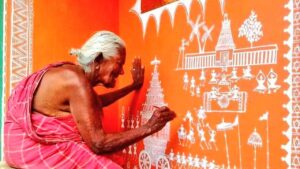A community that holds grace, a community that worships fire, a community that went through a tragic immigration situation from Iran and landed on the ground of diversity in India. Here is the Parsi community that embraces gem-like talents in themselves.
Drive through this Rarity of Gara Embroidery
As much as the people of the Parsi Community are unique their elegance is twice rare of it and this is a fact nobody can really deny. Gara embroidery stitched with sheer beauty and photorealistic precision steals attention at only first sight. Primarily worn by the Parsi community during special ceremonies and weddings, it surely oozes out exquisiteness.

Origin of Gara Embroidery
It was a time when the Parsis from India used to travel to China for trading cotton and opium in exchange for tea from China. As tea was a popular beverage in Europe and the British had a desire to have an increment in tea, Parsis quickly started becoming rich by having a trade with the British.

Not just tea, there were ceramics and distinct other antiques that held eyes of beauty and fables state that one of the traders had brought artistry that had exceptional embroidery which depicted the flora designs that were truly realistic and also an eye-catcher for the European market. Later the embroidery was trailed down in the form of saree.

The first phase started by having fully embroidered sarees, and corner-to-corner ones, but women gradually started traveling to China and altered them to have borders, leaving some empty spaces to create a perfect tuck-in. As the settlement of Parsis was new in Bombay with a high-class status they wanted a signature look and Gara sarees did them pure justice.
Gara and its Designs
One of the famous designs was ‘Cheena Cheeni,’ depicting a Chinese couple against a scenery of pagodas, plantations, and bridges along with people doing daily chores in China. These designs were so unique and unseen that they became a prized possession.

Polka Dotted Motif- Kaanda Papeta
Classic design that never runs out of trend. And this was a popular motif with a quirky name of ‘Kaanda Papeta’ meaning, onions, and potato. Back then polka dots were so common that they were compared with onions and potatoes.

With the love of flora and fauna there were designs motivated by a hen and a rooster that was given the name of ‘Marga Margi,’ and ‘Chakla Chakli,’ which translates to male and a female sparrow. Not just this but spiral figures were also the catch back in the time given a name of ‘Karoliya’ or a spider.


The delicacy of Gara Embroidery on a saree
Taking from up to three weeks to anywhere between three months this Gara embroidery is specially done by 6-8 people working on a single piece of saree that is covered in silk thread. A floaty saree that is clever, originally the fabric is called ‘Sali Ghaj’ which has thin lines running through it.

Also check out!!
Independence Special: Foot and Mouth Painter’s Ideology of Democracy




